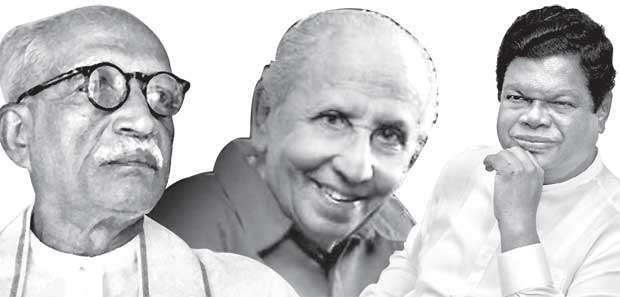Reply To:
Name - Reply Comment
Last Updated : 2024-04-16 10:08:00

I mentioned in the first part of this series of articles that I agreed with Bandula Gunawardene. But then, there’s no real reason to doubt that the other side, i.e. those who root for international schools, have their stories to tell as well. So before going any further, let me come out with it again: as long as the issue we’re talking about is the problems, deficits, and anomalies of the system, I am with Mr. Gunawardene. In other words, as long as the argument is that we have opened the education system to privatisation without any corresponding quality check, I believe that we need to rethink our policy on international schools. 
But he did not make this point clear. Instead he rambled on about the problem of comparing marks of students from government and private schools with those of students from institutions registered outside the Ministry. It was an attempt at finding fault, not with the system, but with the man in charge of the system; it was a case of claiming credit: “When I was the Minister of Education, questions were raised over international school students sitting for local exams.”
The problem with this approach is that it conveniently trivialises the reasons as to why these private institutions materialised and the fact that one cannot generalise and argue that they are all (for the lack of a better word) bad. There are institutions and there are institutions, some of them different, the others alike.
The earliest international schools in Sri Lanka were formed in the early part of the 1980s. These were the high fee levying institutions, and many of them were open to children of diplomats who had earlier sent them to popular schools which had taught in English even after the Kannangara reforms. In other words, it was the absenting of English as a medium of instruction for a period of almost 20 years which facilitated the establishment of an alternative sector. It goes without saying that not a few of these new schools had been started as tuition kades.
Then in 1985, the Education Ministry laid down rigid criteria for the selection of what were then called “national schools”. Only 18 institutions qualified for this label that year. More pertinently, it was around this time that these new private enclaves, which had catered to the expatriate and diplomatic community, were opened to locals, though in the first few years only the upper class could afford the fees.
Even today, the older institutions tend to be attended by the new elite. There was, given this, another cleavage: the new school industry had left out the emerging bilingual/monolingual middle class. They formed part of another elite, but they were distinguishable by their middle class traditionalism. Most of them happened to be traders, small business owners, and senior government servants.
It was to fill this gap that a second stratum of international schools came out in the early and mid 90s. I attended one of these institutions, and I can attest that, after 12 years of studying in there, to me they represented a mishmash of cultural and foreign values. They were catered to the local middle class that could not enter their children to public schools, yet could not afford the luxury of established international schools. I need hardly add that the girl who obtained the highest score in the Arts stream came from one of these institutions, and that the institution she hails from was founded by a friend of Mr. Gunawardene who was also once a famous private tutor.
There’s nothing much to be said for these schools, except that they represented, strangely, a blend of the foreign and the local; they were certainly more attuned with cultural pursuits than the older institutions, yet (and this is a paradox I still have not been able to tackle) they were also disdainful of certain cultural specifics. I am not a little thankful for the education I received here, though at times I wonder whether it would have been more worthwhile to have studied in the language of my birth.
In the meantime, the public education system flourished, though at a price. The number of national schools, owing to the politicisation of the sector, increased rapidly during the Premadasa and Chandrika years, and the pressure of putting children into them increased with it: according to Eric J. de Silva the number ballooned from 37 in 1992 to more than 310 a decade later. But the hike was not met with a corresponding rise in quality; the fiasco over the reintroduction of the English medium proved as much. The inadequacies of the system thus eventually resulted in what they had usually resulted in. A third stratum of international schools came out.
These third layer schools are both unsettling and puzzling, for the reason that they were never established as international schools. Most of them teach the local syllabus in English; many of them are situated in the peripheral areas of major towns; they hire teachers from local areas and the quality of teaching is, perhaps given this, worse than you think; they are built in small areas that have virtually no room for playgrounds or recreational activities; and they charge fees which, are a pittance when compared with the fees of the first and second layer institutions, consume the earnings of those who send their children. The parents of some of the students don’t even have jobs, and many of them are self-employed artisans: carpenters, plumbers, trishaw drivers.
The colonial education system thrived on a rift between those who had and those who hadn’t. With the institutionalisation of free education, elite and non-elite schools were faced with an onslaught of both sections of the population. 1956 has been vilified and celebrated for all the wrong reasons there, but I think that the biggest achievement of Bandaranaike’s policies was the emancipation of the rural petty bourgeoisie from the hegemony of the bourgeoisie. This was the section of the population that Lester James Peries valorised in his films, especially Golu Hadawatha. They were, therefore, the biggest beneficiaries of free education.
But there was always a fatal contradiction between an education system grafted on a foreign model (the English public school model, which Kannangara went for even as he established Central Schools for the rural poor) and a system that had been opened to those who simply could not be accommodated by the foreign model. The result was – what? A rift between equality and equity: the sons of mudalalis sat alongside the sons of the mason baases, projecting a veneer of equality which gradually turned in on itself. There’s no point in bringing every class together if the cleavages among them are not addressed. And yet – this is most pronounced in the Grade Five Scholarship – they continued to be unaddressed.
"Free education scheme introduced in 1945 did not have an immediate impact on the ordinary people of the country. All it did initially was to waive the fees in English schools"
I think Prof. Carlo Fonseka put this in perspective rather well:
The free education scheme introduced in 1945 did not have an immediate impact on the ordinary people of the country. All it did initially was to waive the fees in English schools. These fees were being paid by the wealthier parents and they were the ones who benefitted immediately from Dr. Kannangara’s free education scheme. The full impact of the free education scheme would necessarily take 20 to 30 years to manifest and the public were not farsighted enough to appreciate this fact. Moreover, free education is a socialist measure... Adam Smith, to my knowledge, never advocated free education.
So there you have it, Mr. Gunawardene. Many of those marketed as beneficiaries of free education, most of those who enter the big schools by dint of the shishyanthwaya, benefit and enter them because they hail from a relatively affluent background. They are not the rural poor whom Kannangara’s proposals were meant to benefit. They are the children of a new petty bourgeoisie: the gramasevakas, the police inspectors, the principals of the game iskole. They are, in other words, a hybridised elite.
Space considerations do not permit me to dwell at length on this, but let me say what should be said: just as the new elite, the middle class, and sections of the rural middle class have become the beneficiaries of the alternative private-international system, the old elite and the new petty bourgeoisie have found a roost in established schools. We shouldn’t think of either of these classes, Mr Gunawardene. We need to focus on the parents and children who have been excluded by both institutional frameworks. The rural poor. Yes, Mr. Bandula Gunawardene. The “ordinary people.”

Add comment
Comments will be edited (grammar, spelling and slang) and authorized at the discretion of Daily Mirror online. The website also has the right not to publish selected comments.
Reply To:
Name - Reply Comment
On March 26, a couple arriving from Thailand was arrested with 88 live animal
According to villagers from Naula-Moragolla out of 105 families 80 can afford
Is the situation in Sri Lanka so grim that locals harbour hope that they coul
A recent post on social media revealed that three purple-faced langurs near t
09 Apr 2024 - 1 - 1161
6 minute ago
9 minute ago

10 Apr 2024
09 Apr 2024